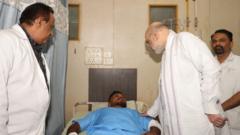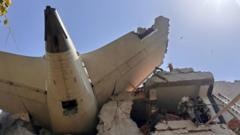As the aftermath of the tragic Air India Flight 171 crash unfolds, families of the more than 270 victims are left in agonizing limbo due to the extreme conditions that hinder identification efforts.
Tragedy and Identification Challenges Following Air India Crash

Tragedy and Identification Challenges Following Air India Crash
DNA identification is complicated as families grieve the loss of loved ones from the devastating Air India crash.
The recent crash of Air India Flight 171 near Ahmedabad has left a profound impact as relatives gather to mourn. Medical officials reported significant challenges in identifying the remains of passengers, following the crash that occurred on June 15, 2025. The Boeing 787-8 Dreamliner, loaded with 125,000 liters of fuel for its near 10-hour journey to Gatwick Airport, erupted into flames upon crashing, reaching temperatures estimated at a staggering 1,500 degrees Celsius (2,700 degrees Fahrenheit).
According to H.P. Sanghvi, director of the forensic lab handling the DNA analysis, the intense heat has severely affected the integrity of the remains, complicating both collection and testing processes. “These high temperatures affect the DNA present in various parts of the body,” he stated, emphasizing the complexities involved in the identification process.
As of Sunday evening, merely 35 bodies had been recovered and returned to their families, compounding the anguish of those waiting for news of their loved ones among the official death toll of 270 victims. The devastation left in the wake of this tragedy amplifies the urgent need for effective identification methods as families continue to grieve and seek closure.
According to H.P. Sanghvi, director of the forensic lab handling the DNA analysis, the intense heat has severely affected the integrity of the remains, complicating both collection and testing processes. “These high temperatures affect the DNA present in various parts of the body,” he stated, emphasizing the complexities involved in the identification process.
As of Sunday evening, merely 35 bodies had been recovered and returned to their families, compounding the anguish of those waiting for news of their loved ones among the official death toll of 270 victims. The devastation left in the wake of this tragedy amplifies the urgent need for effective identification methods as families continue to grieve and seek closure.




















